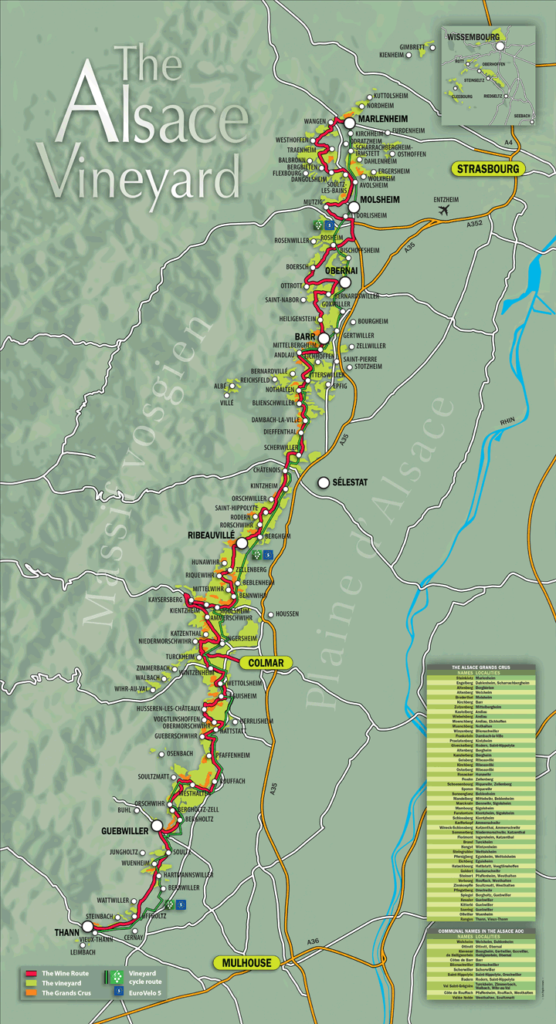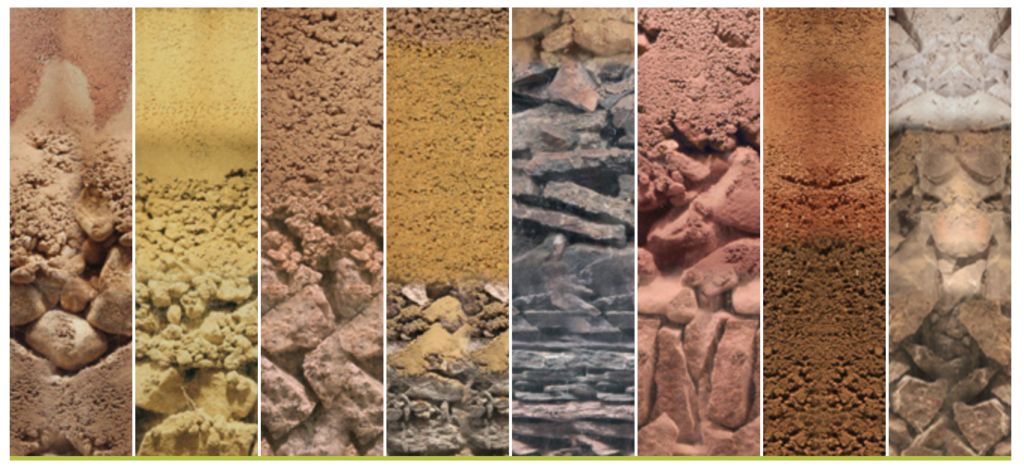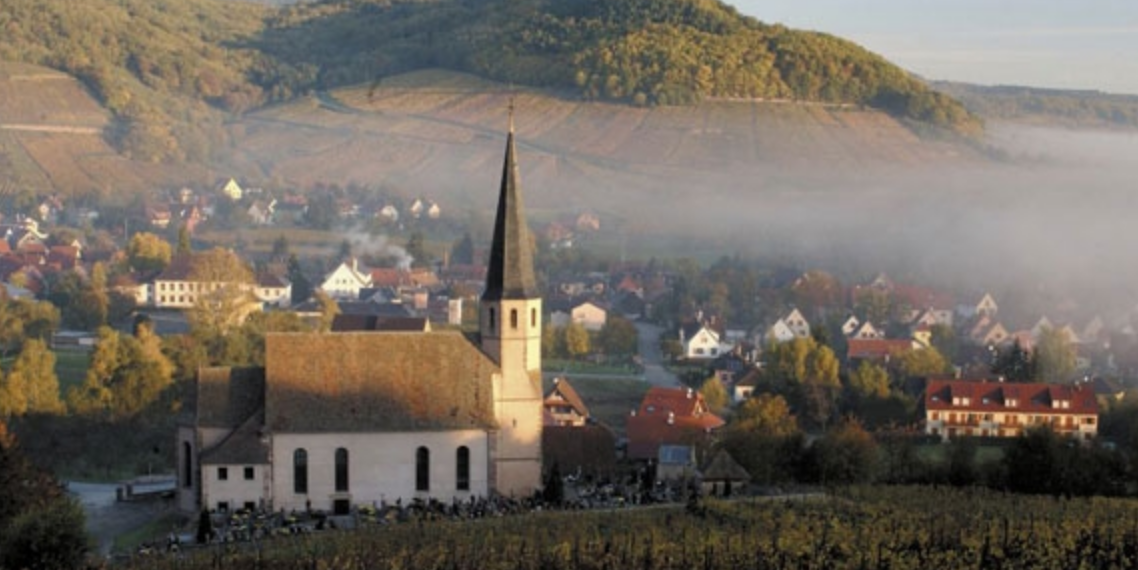Alsace – the land of Riesling and Gewurztraminer. But what more can we say about this famous wine region in the top corner of France? Here’s our Fast Facts and Alsace guide, its wines and the wine region taking in all the terroir essentials including the climate, average temperature, soil types, wine varieties and winemaking techniques.
Where is the Alsace anyway?
Alsace has been a disputed territory between France and Germany for generations. Today it is French, and sits on the eastern border hugging the Vosges Mountains and separated from Germany by the Rhine river. On a trip to Alsace today you’ll likely hear both French and German spoken, and while you will be drinking vin it may well be served with sauerkraut.
The Essentials of Terroir: Alsace guide
 Climate & Landscape
Climate & Landscape
Alsace is a narrow wine valley that runs from north to south between the rhine river and the Vosges mountains, along the border with Germany. The climate is continental with cold winters and warm, dry summers. Frost, hail and even drought can be problematic in Alsace.
Average temperature Alsace wine region
The average summer temperature is 18°c (although it can peak in the 30s) and in winter it is 3.5°c.
Alsace rainfall
Alsace has one of the lowest average rainfalls in France. Reason being, the wine region is largely in the rain shadow caused by the Vosges mountains. Although rainfall varies dramatically depending on the site, an annual average is 500mm per year. In general there is a higher rainfall in the north where the mountains are lower.
Alsace Latitude
7.44° E
Alsace Longitude
48.31° N
Alsace altitude
Vineyard altitudes range from 175m to 550m above sea level, creating a wide range of different micro climates and diversity in the wine region. The higher altitudes are largely covered by forests.
Alsace guide to soils

Main soils, left to right: Marl-Limestone; Marl-Limestone-Sandstone; Granite; Clay-Marl; Schist; Sandstone; Colluvial-Chalk; Volcanic
Alsace has a huge mix of soils with 13 distinct types of soil found in the region, and differences in vineyards within 100 meters. The plains have fertile alluvial soils and are not as highly regarded as the soils found on the slopes. The steeper mountain slope vineyards have a poor and thin topsoil with subsoils of volcanic soils, granite, sandstone and schist; whereas the gentler slopes are based on river bed soils and have much richer topsoils with a mix of clay, marl, limestone and sandstone.
Viticulture: Alsace guide
The viticulture techniques in Alsace are all about capturing as much light as possible, especially on the slopes.
The vine density is of around 4,400 – 4,800 vines per hectare, trained in Guyot or Cordon method. The vines planted on the plains are trained quite high off the ground in order to reduce frost risk, as the cold air sinks to the lower zones.
The harvest usually starts in September and might continue into January for the late-harvest, botrytised wines. On the slopes (and for botrytis wines) the harvest is done by hand, but on the plains it is often a mechanised harvest.
Alsace guide: the wines
Alsace shares a lot with Germany in terms of wine style:
- Most of the wine is white (90%);
- There is little use of oak, they tend to be fresh fruit focused; and
- They are typically single variety (whereas French wine is dominated by blends).
- (Alsace AOC wines are also bottled in the traditional green flute glass – under the AOC law of 1972 – which is also popular in Germany.)
All the still wines of Alsace are split into either Alsace AOC (the large majority) and Grand Cru AOC (4%). There are 51 Grand Cru in Alsace, delineated by site/village (which are all on the slopes, not plain). These Grand Cru wines have stricter appellation rules:
- Must be made from Riesling, Gewurztraminer, Pinot Gris and Muscat d’Alsace (with the exception of Sylvaner in Zotzenberg)
- No acidification of wines. Chaptalization must be requested and agreed upon by Grand Cru syndicate.
- There are pruning guidelines, density limits (minimum 4500 vines/ha) and yield limits (55hl/ha).
For both Alsace AOC and Grand Cru wines, most wines are bottled, and labelled, as single variety (meaning it is 100% of the variety). If the name of the variety is not on the bottle they are likely blends. Sparkling wines fall under Crémant d’Alsace AOC and can be white or rosé.
Wine Grape Varieties

Wine production in Alsace is really dominated by the big three:
- Riesling: over 20%
- Pinot Blanc: over 20%
- Gewurztraminer: almost 20%
After that follows Pinot Gris (around 15%), Pinot Noir (10%) and other varieties including notably Sylvaner. Each of these wines are made into dry white, red and rose, as well as a range of off-dry white wines.
Sweet wines also make an appearance in Alsace and can be categorised in the following way:
- Vendange Tardive – A late-harvested sweet wine (can, or cannot, be botrytis) from a single vintage made from Riesling, Muscat, Gewurztraminer, or Pinot Gris. They must have a natural minimum sugar of 220 g/l (Riesling & Muscat) or 243 g/l (Gewurztraminer & Pinot Gris).
- Sélection de Grains Nobles – An even later-harvested sweet wine, usually affected by botrytis (aka. noble rot) and much more concentrated and sweet. This time with a natural minimum of 256 g/l (Riesling & Muscat) and 279 g/l (Gewurztraminer & Pinot Gris).
Crémant d’Alsace
Made by traditional bottle fermentation, AOC Crémant d’Alsace wines are elegant sparkling wines usually made from an early-harvest of Pinot Blanc, Pinot Gris, Pinot Noir, Riesling and Chardonnay*. The style is characterised by fresh, bright acidity and has a rather attractive price point too.
*Chardonnay is only permitted in Crémant d’Alsace, not in regular still wines from Alsace.
Local wine pairings
With a strong Germanic heritage in its cuisine, Alsace has a typically sweet and sour style of cuisine that works well with the high acidity, refreshing white wines. Typically the local Choucroute is paired with dry and off-dry aromatic white wines, which also work nicely with creamy sauces for meats and pasta.
Business & Producers
Alsace has over 4,000 growers, almost a thousand of which produce wine too, but more than half of the region’s wine production (60%) in Alsace is sold by co-operatives or large negociants.
Interesting Facts: Alsace guide
After the devastation of the widespread oidium and Phylloxera outbreaks of the late 1800s, most of the region was replanted with tougher hybrid varieties on the flatter plains. The hillsides – which are renowned for quality today – were abandoned. The silver lining is that these abandoned vineyards were now ripe for replantation with better clonal material of vinifera varieties on American rootstocks following the French re-occupation of the Alsace after WW2.
Alsace Resources
Useful pages and photos sourced from:


